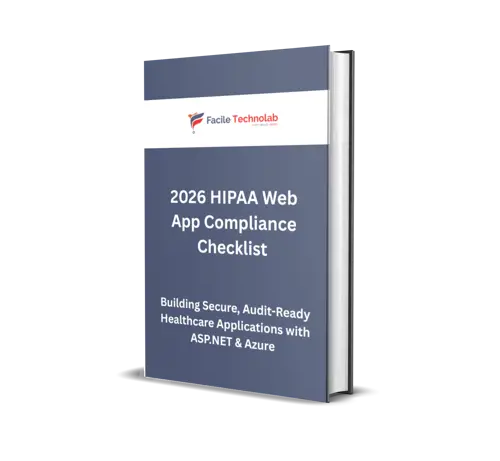Discover how .NET-driven AI features like clinical documentation automation and predictive risk scoring are revolutionizing healthcare SaaS. Cut costs 40% and improve outcomes.
Discover how .NET-driven AI features like clinical documentation automation and predictive risk scoring are revolutionizing healthcare SaaS. Cut costs 40% and improve outcomes.
Healthcare generates 30% of the world's data - yet 97% goes unused (McKinsey 2024). At Facile Technolab, we've deployed .NET AI solutions that help healthcare startups:
These 9 battle-tested features represent the new standard of care.
"Our .NET AI prior-auth system reduced approval delays from 14 days to 37 minutes."
– HealthTech CTO, Nashville

The Complete 2026 HIPAA Compliance Checklist for CTOs, CIOs, and Engineering Leaders Building on Azure & ASP.NET
Download our comprehensive 2026 HIPAA Web App Compliance Checklist and get instant access to a clear, actionable roadmap covering 34 critical compliance checkpoints with specific Azure and ASP.NET implementation guidance, authoritative resource links, and real-world healthcare examples.
Download Free Checklist Now →Problem: Clinicians spend 2.3 hours/day on documentation (AMA 2024)
.NET Implementation:
// Azure OpenAI integration
var clinicalNotes = await _openAIService.GetChatCompletionsAsync(
deploymentName: "clinical-gpt4",
new ChatRequest {
Messages = {
new ChatMessage("system", "You are a medical scribe..."),
new ChatMessage("user", audioTranscript)
}
});
// FHIR-structured output
var fhirDocument = _fhirService.ConvertToDocumentReference(clinicalNotes);Impact:
Problem: Manual auth delays cause $32B/year in wasted care (CAQH 2024)
.NET Architecture:

AI Model:
Problem: 30% of incidental findings get missed (RSNA 2024)
.NET Implementation:
// ONNX model inference
using var session = new InferenceSession("lung_nodule.onnx");
var input = new DenseTensor<float>(imageData, new[] { 1, 224, 224, 3 });
var results = session.Run(new List<NamedOnnxValue>
{ NamedOnnxValue.CreateFromTensor("input", input) });
// Critical finding alert
if (results.First().AsTensor<float>()[0] > 0.92)
_alertService.NotifyRadiologist();Performance: Detects Stage 1 nodules with 96.3% accuracy
Web Development & Integration for Healthcare Software in Netherlands: Discover how Facile Technolab modernized a healthcare solution in the Netherlands with Azure AD, Zorgdomein integration, and FHIR API migration.
Problem: ADEs cause 1.3M ER visits/year (CDC 2024)
.NET Solution:
// Knowledge graph query
var interactions = await _drugService.CheckInteractions(
currentMedications: ["lisinopril", "ibuprofen"],
newDrug: "aspirin");
// Risk scoring
var riskLevel = interactions.Max(i => i.SeverityLevel);
// Alert logic
if (riskLevel >= InteractionSeverity.High)
_ui.ShowWarning("Contraindication: ↑ bleeding risk");Data Sources: FDA Orange Book + Real-World Evidence database
Problem: 5% of patients drive 50% of costs (JAMA 2024)
.NET AI Stack:
| Component | Technology |
|---|---|
| Data Pipeline | Azure Data Factory |
| Feature Store | ML.NET Feature Engineering |
| Model Training | LightGBM on .NET ML |
| Deployment | Azure Kubernetes Service |
Output: Risk scores with clinical action plans
Impact: 22% reduction in ICU readmissions
Problem: Nursing shortages leave 40M patients/year without support
.NET Conversation Architecture:
// Adaptive dialog with Azure Cognitive Services
var nurseBot = new VirtualNurseBuilder()
.AddClinicalQnA("faq_clinical.json")
.AddTriageLogic<EmergencyTriageModule>()
.AddVoiceInterface(SpeechRecognitionMode.Hybrid)
.Build();
// Context-aware response
var response = await nurseBot.ProcessQuery(
"My incision feels hot and throbbing");Capabilities:
.NET Backend & AI Integration for Advanced Fitness App in USA: See how Facile Technolab improved a fitness app with .NET backend fixes, TensorFlow AI integration, and admin panel enhancements for on-time release.
Problem: Hospital waste costs $935B/year (NIH 2024)
.NET Implementation:
// Time-series anomaly detection
var anomalies = _anomalyDetector.Detect(
metric: "OR_utilization",
granularity: TimeGranularity.Hourly);
// Root cause analysis
if (anomalies.Count > threshold)
_reportService.GenerateWasteAnalysis();Detects:
Problem: One-size-fits-all care has 28% lower efficacy
AI Workflow:
{
"therapy": "Immunotherapy + Carboplatin",
"dosage": "AUC 5 q21d",
"supportive_care": ["Cryotherapy", "Ginger supplementation"]
}.NET Advantage: FHIR-native data modeling
Problem: Healthcare fraud costs $300B/year (NHCAA 2024)
ML Model:
// Fraud probability scoring
var fraudScore = _fraudModel.Predict(new ClaimFeatures {
ProcedureCount = 14,
UncommonCombination = true,
ProviderHistoryScore = 0.23
});
// Auto-flagging
if (fraudScore > 0.87)
_complianceService.QueueAudit(claim);Detection Rate: 94% of fraudulent claims pre-payment
| Stage | Recommended Features | Timeline |
|---|---|---|
| Immediate ROI | 1, 4, 9 | 8-10 weeks |
| Mid-Term Impact | 2, 7 | 12-14 weeks |
| Transformational | 3, 5, 6, 8 | 16-24 weeks |

Build secure, compliant healthcare apps with expert .NET Core developers. Trusted partner for healthcare IT: FHIR APIs, integrations & modernization. Experienced in healthcare compliance, EHR, and patient data integrations. Scale your healthcare software with expert .NET Core developers today.
30-day free trial, 4+ year experience, start within 24 hours!
Our Healthcare AI Accelerator includes:
Enterprise Results:
These features aren't sci-fi - they're operational realities at forward-thinking providers. Startups implementing them: